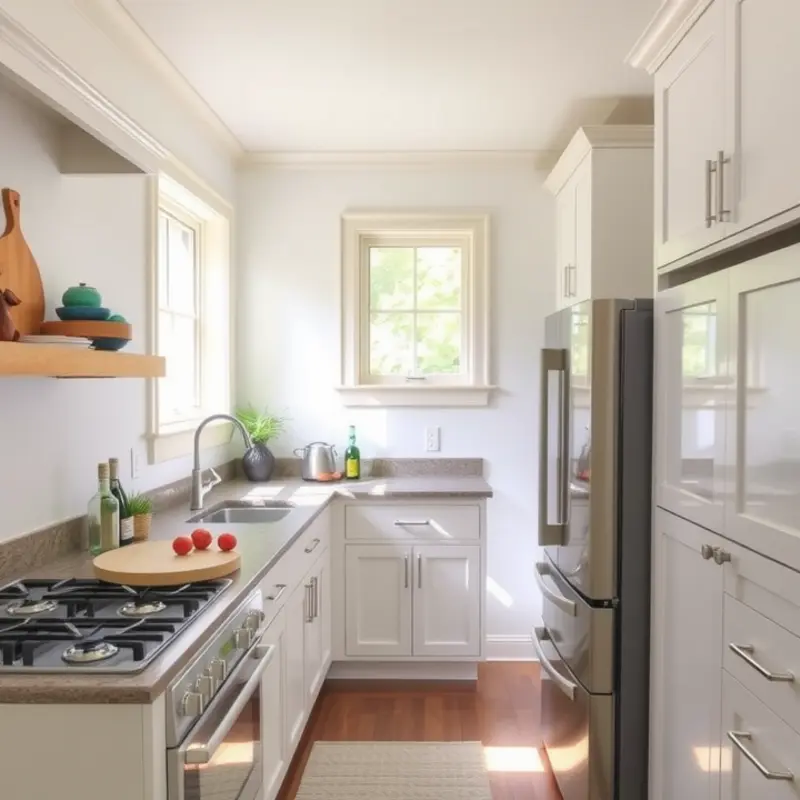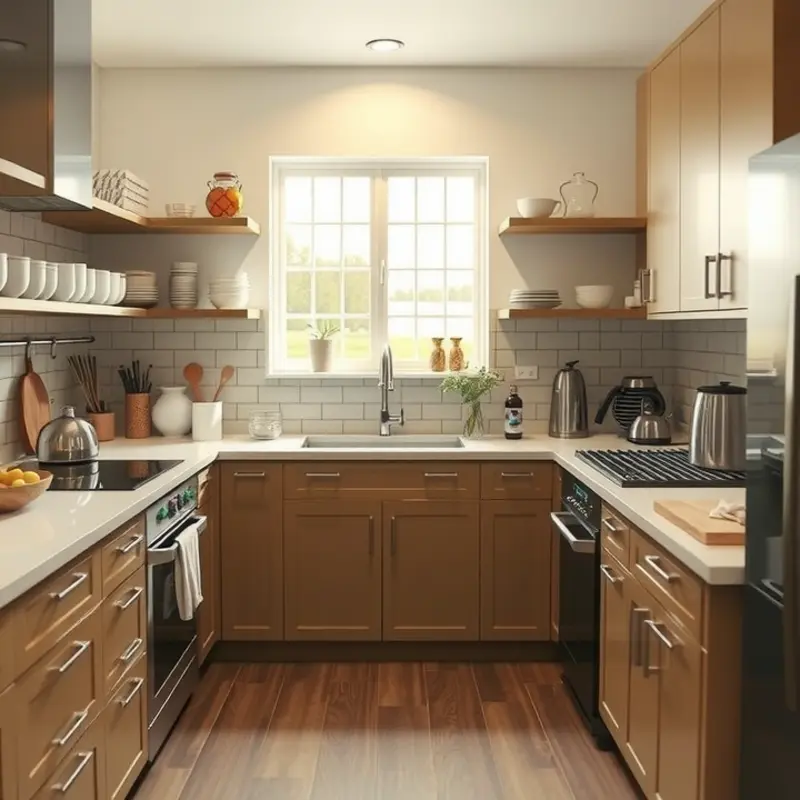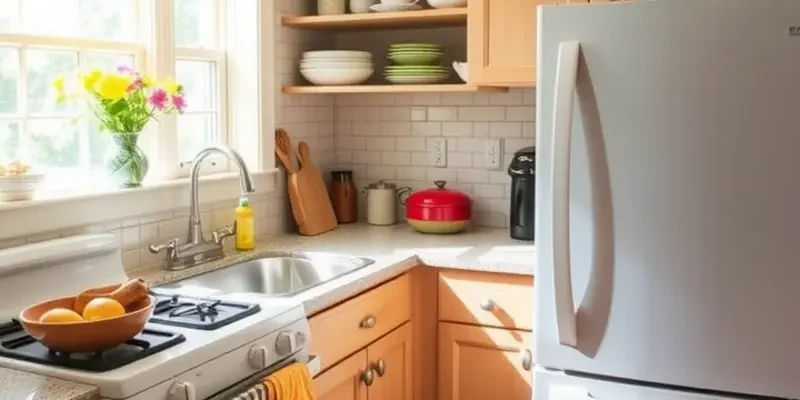Creating an efficient kitchen layout is vital for home cooks looking to elevate their culinary skills. A well-organized kitchen not only enhances productivity but also makes cooking a more enjoyable experience. By implementing simple and practical tips, you can create a workspace that allows you to navigate seamlessly from preparation to plating. Let’s explore how to optimize your kitchen for maximum efficiency and creativity.
The Work Triangle: A Fundamental Blueprint

Understanding the concept of the work triangle is the bedrock of designing a kitchen that promotes efficiency and ease of use. The work triangle is a practical layout that connects the three main work areas in the kitchen: the stove, sink, and refrigerator. This configuration is intended to streamline meal preparation and increase productivity by minimizing unnecessary steps.
To achieve an optimal workflow, these three elements should form a triangular pattern. The design should ensure that neither the distance between each component is too great, causing inefficient movement, nor too close, resulting in a cramped space. Ideally, the distances should range between 4 to 9 feet, allowing for smooth, unobstructed access to each point. This careful arrangement simplifies meal preparation, keeping you organized and reducing the time you spend in transit between tasks.
Alongside understanding spatial dynamics, organizing your kitchen tools can amplify the benefits of a well-planned work triangle. Keeping frequently used utensils and ingredients within arm’s reach of their corresponding work zone can significantly enhance multitasking capabilities. For instance, storing your pots and pans near the stove, keeping the cutting board and knives by the sink, and placing often-used ingredients in proximity to the refrigerator can shave minutes off your preparation time.
Maintaining a clutter-free kitchen is equally crucial in ensuring a seamless cooking experience. Clutter can distract and slow you down, adding unnecessary complexity to your culinary endeavors. Reducing countertop appliances and keeping your workspace tidy amplifies the efficacy of the work triangle, helping you focus on the tasks at hand.
Another key element is to periodically assess and adjust your kitchen layout. Every cook’s needs evolve over time, influenced by cooking styles, household changes, and personal preferences. A seasonal audit of your kitchen space can provide insights into what’s working and what needs altering to better suit your evolving culinary habits. These adjustments can make a substantial difference in how pleasant and efficient cooking becomes.
For those interested in enhancing not just the layout but the health benefits of cooking at home, understanding the health advantages of homemade foods can offer additional motivation to refine your kitchen setup. Incorporating these insights ensures that your kitchen not only remains a space of creativity and flavor but also of health and wellness.
By investing the time to optimize your kitchen’s work triangle, you can transform cooking from a chore into a more streamlined and enjoyable activity. This foundational setup helps you save time, reduces physical strain, and encourages you to explore and enjoy your culinary passions with newfound efficiency.
Zones and Accessibility: Tailoring Your Cooking Station

Creating an efficient kitchen begins with understanding how to set up zones that enhance your workflow. Imagine your kitchen as a series of dedicated areas, each serving a specific purpose. These zones are crucial for dividing the labor of cooking into manageable, defined spaces.
Start with the preparation zone, which is the heart of your kitchen’s workflow. This area should house your cutting boards, knives, and prep bowls. Ideally, keep this zone close to both the sink and the stove, allowing you to wash, chop, and move ingredients to the heat source seamlessly. Having these items within arm’s reach minimizes unnecessary movements, saving time and effort.
Next, consider the cooking zone, specifically around your stove and oven. Store your pots, pans, and cooking utensils nearby. Designate a section of your counter to hold oils, salts, and frequently used spices. Incorporating a spice rack or a magnetic strip for knives can be a space-saving strategy that increases efficiency. In this zone, always prioritize safety by keeping handles turned inward on the stove and keeping flammable items away from heat.
The serving zone comes into play once your meals are cooked. Plates, bowls, serving utensils, and trivets should be stored close to this area, typically near the dining space if possible. Having a counter space dedicated to final touches like garnishes helps streamline the transition from kitchen to table.
Finally, the often-overlooked cleaning zone ensures your kitchen resets smoothly after each cook session. Place your dishwasher close to the sink and keep dish soaps, sponges, and dishtowels neatly organized beneath the sink. A small compost bin in this area encourages efficient disposal of scraps, aligning with sustainable cooking practices.
Organization tools play a pivotal role in maintaining these zones. Drawer dividers help keep utensils sorted, preventing them from turning into a jumbled mess. Clear containers for pantry items make identifying needed supplies quick and easy. Labeling shelves and containers is another straightforward way to ensure everything returns to its designated spot after use.
Accessibility is another aspect that cannot be overlooked. Ensure that frequently used items reside at waist height to avoid repetitive bending or stretching. Place lighter items on higher shelves and heavier items lower to prevent strain.
Finally, free up counter space to guarantee you have enough room to maneuver comfortably. Avoid overcrowding surfaces with appliances or decor. Instead, strive for a balance that supports your culinary endeavors without obstruction.
By tailoring each zone to your specific needs and habits, you foster a kitchen environment that not only supports your cooking style but also makes the entire cooking process more enjoyable.
Final words
An efficient kitchen layout can transform the way you approach cooking, allowing for a seamless and enjoyable experience. By implementing the work triangle concept and organizing your kitchen into functional zones, you empower yourself to create culinary delights with ease. Assess your space and make the necessary adjustments to unlock your kitchen’s full potential. Remember, an organized space not only enhances productivity but also nurtures your passion for cooking. Embrace these tips and take your kitchen skills to the next level.







